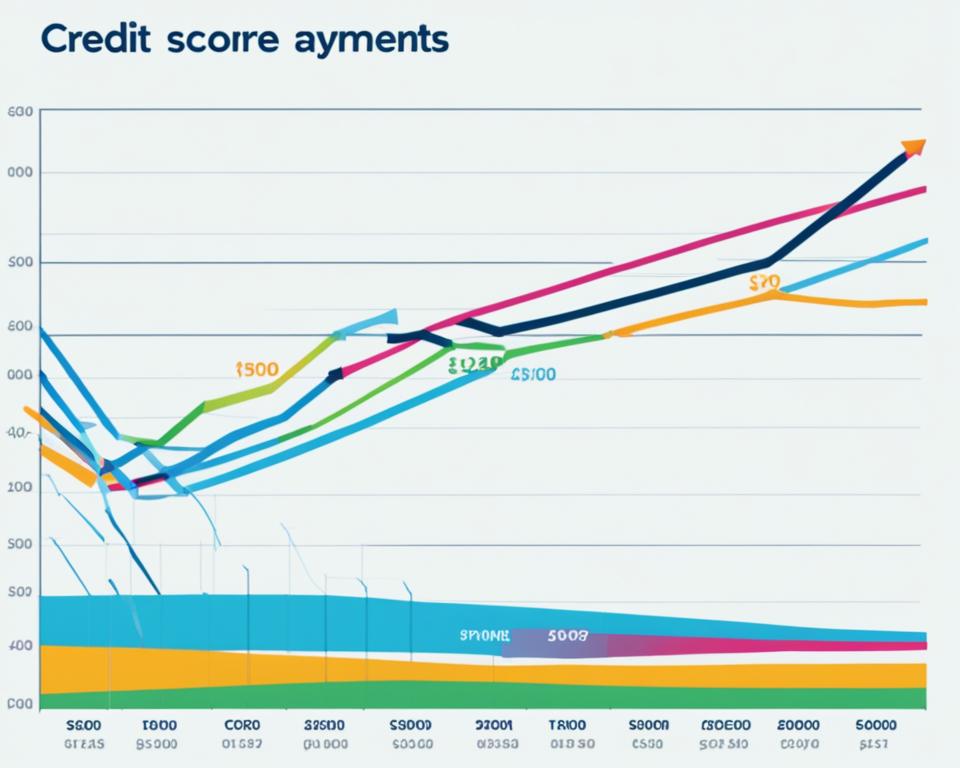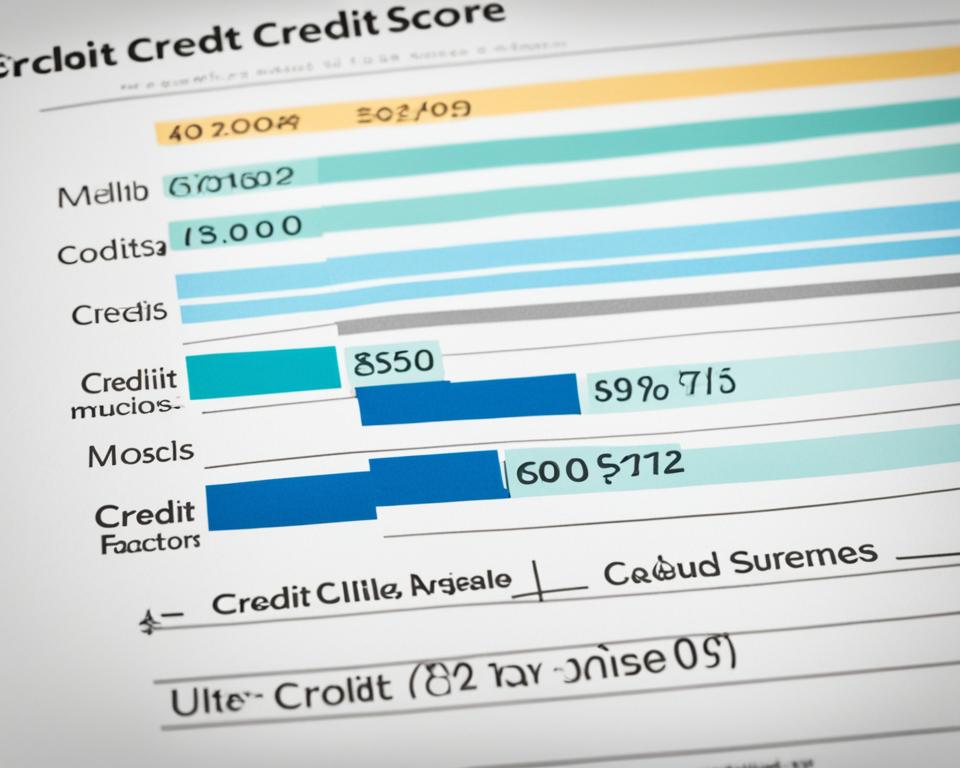When it comes to financial stability, one of the most pivotal metrics that lenders, and indeed many consumers, focus on is the credit score. In the United States, the procedure to calculate credit score formulas presents a complex landscape where various credit scoring models come into play. Among these models, the FICO score is particularly prominent, offering a gauge for lenders to assess potential risk when granting credit.
The behind-the-scenes mechanics of credit score calculation methods remain somewhat of a mystery due to proprietary algorithms. However, what is well understood is that they are composed of a set of critical factors. These include payment history, amounts owed, and several others that collectively provide a numerical representation of an individual’s creditworthiness.
An overview of these credit scoring models is essential for any consumer looking to navigate the credit landscape effectively. It’s the cornerstone of financial health and a tool for securing better interest rates and financial products. Therefore, keeping abreast of how one’s credit score is articulated and shifts over time stands as a fundamental aspect of money management.
Key Takeaways
- Credit scores are crucial for lenders to evaluate the risk associated with a borrower.
- The FICO score is one of the leading metrics used to understand a borrower’s credit history and likelihood of repayment.
- Five main factors, each with its weighted significance, culminate in the calculation of one’s credit score.
- Known credit score calculation methods reflect credit behavior, debt management, and credit history.
- Monitoring one’s credit score is key to proactive financial management and long-term planning.
What Is a Credit Score and How Is It Calculated?
At its core, the credit score definition encompasses a numerical expression that financial institutions use to measure an individual’s creditworthiness. It reflects a comprehensive evaluation of one’s past fiscal behaviors and helps predict future credit risk.
In the United States, many lenders turn to the FICO scoring model to make informed decisions. The Fair Isaac Corporation, which attributes its name to this model, has established itself as a bellwether in assessing credit risk. This quantification of financial reputation is essential not only for lenders but also equips consumers with knowledge crucial to navigating fiscal negotiations.
Definition and Purpose of a Credit Score
The essence of a credit score lies in its ability to forecast the probability of a borrower repaying their debts timely and consistently. From mortgages to car loans, managing these scores effectively can open doors to more favorable borrowing terms.
Overview of the FICO Scoring Model
The FICO model is meticulously engineered to transform raw data from one’s credit history into a forecast tool. With various contributing factors, the system offers a clear indication of what to expect from borrowers. Although the exact algorithms of FICO remain proprietary, its structure is transparent, focusing on elements such as payment history and credit utilization.
Understanding the FICO model is integral for anyone striving to improve their financial health. Regular review and comprehension of one’s credit report, which serves as the basis for calculating a credit score, can aid in devising strategies to boost financial standing and unlock better opportunities.
The Five Fundamental Factors for Calculating a Credit Score
When trying to determine credit score factors, it’s essential to understand the five key components that FICO credit scores hinge on. These elements each carry a certain weight in the credit score calculation, influencing the overall score to varying degrees. Let’s delve into the significance of each component and how they collectively determine one’s financial credibility in the eyes of lenders.
Breaking Down the Percentage Weight of Each Factor
At the heart of the credit score calculation lies a set of carefully measured variables, each contributing a fixed percentage to the overall score.
| Factor | Percentage Weight | Description |
|---|---|---|
| Payment History | 35% | Tracks the consistency of on-time payments, late payments, bankruptcies, and past due amounts. |
| Amounts Owed | 30% | Examines credit utilization ratios and overall debt compared to available credit. |
| Length of Credit History | 15% | Considers the duration your credit accounts have been active, rewarding longer credit histories. |
| New Credit | 10% | Reflects the impact of recent credit accounts and inquiries on your score. |
| Credit Mix | 10% | Assesses the diversity of credit accounts, such as credit cards, retail accounts, installment loans, and mortgages. |
The meticulous configuration of these factors is what allows the FICO scoring model to produce a nuanced portrayal of an individual’s creditworthiness. A strong payment history and low credit utilization ratios are especially pivotal, as they account for the majority of the score’s weight. Conversely, while new credit and the credit mix hold smaller percentages, their optimal management can still positively sway your overall credit evaluation. By staying informed and managing these components wisely, consumers can work towards achieving and maintaining a high FICO score.
Exploring the Impact of Payment History on Your Credit Score
Within the intricacies of the credit rating calculation process, one factor stands out due to its significant influence: payment history. This component is critical as it chronicles an individual’s punctuality and reliability in fulfilling financial obligations. Notably, payment history is the most prominent determinant, carrying a weight of 35% in the FICO score model.
A well-maintained payment history signals to lenders that the borrower is less of a risk, which can lead to more favorable credit terms and interest rates. It encapsulates a record of payments across various credit accounts, including credit cards, loans, and mortgages. Conversely, infelicities such as late payments, delinquencies, or even bankruptcies can tarnish this history, subsequently impairing one’s credit score with lasting repercussions.

To provide a clearer picture of the impact of payment history on credit scores, let us consider the common occurrences that credit bureaus monitor:
- On-Time Payments: Demonstrates financial responsibility and discipline.
- Missed or Late Payments: These raise red flags about reliability and can adversely impact the score.
- Delinquencies: Extended periods of missed payments that degrade the borrower’s credibility and score.
- Public Records: Bankruptcies and other legal judgments can severely compromise credit scores.
- Collections: Accounts that have been handed over to collection agencies indicate serious payment issues.
As lenders dissect these payment patterns, they gain insights into the fiscal responsibility of potential borrowers. Regular, timely payments nurture a robust credit score, serving as a testament to financial stability. However, credit restoration becomes necessary when late payments and derogatory marks besmirch an otherwise clean record.
The bottom line is unequivocal: maintaining a spotless payment history is indispensable for an impressive credit score and a smoother credit rating calculation process. This history not only fosters a fruitful relationship with current lenders but enhances the prospect of favorable outcomes in future credit endeavors.
Debt-to-Credit Ratio: How Your Debt Affects Your Score
One of the most significant indicators of your financial health in the eyes of lenders is the debt-to-credit ratio, also known as your credit utilization ratios. Representing 30% of your FICO score, this ratio offers a snapshot of how you manage your existing credit in relation to the total amount of credit available to you. A lower ratio is suggestive of prudent credit usage and boosts your creditworthiness, while higher ratios may indicate potential financial stress and risk.
Understanding Credit Utilization
Credit utilization is the percentage that represents how much of your available credit is currently in use. To improve your credit score, financial experts frequently recommend keeping this figure below 30%. This disciplined approach signals to potential creditors that you are not overly reliant on credit and are capable of managing your debts effectively.
For instance, if you have a total credit limit of $10,000 across all your cards and you have a balance of $3,000, your credit utilization ratio would be 30%. This is the line of demarcation often cited as the maximum to maintain a good credit standing.
The Significance of Amount Owed in Credit Calculations
The term ‘amount owed’ doesn’t just refer to the absolute dollar amount of debt. Instead, it encompasses both your credit utilization and the diversity of balances across various accounts. The combination of these subtleties forms a more detailed picture of your amount owed, which plays a central role in FICO’s calculations for credit scoring.
It’s not just about how much you owe, but also where and how these debts are spread. For example, the same amount of debt may be perceived differently if it’s centralized on a single card versus evenly distributed across multiple credit lines. Furthermore, a blend of small balances on a few accounts is generally preferred over a single maxed-out credit card account.
Here, we can break down how different utilization levels might look:
| Credit Limit | Balance | Credit Utilization Ratio |
|---|---|---|
| $20,000 | $6,000 | 30% |
| $20,000 | $2,000 | 10% |
| $20,000 | $10,000 | 50% |
The table illustrates that lower credit utilization ratios are better for your credit score. For those looking for improve credit score tips, paying down existing debts to reduce your overall credit utilization will benefit your credit score considerably.
Ultimately, maintaining a low debt-to-credit ratio is an ongoing process, reflecting a responsible approach to credit management. Regular monitoring of your debts, combined with mindful spending and timely payments, can lead to significant improvements in your FICO score over time.
The Role of Credit History Length in Credit Scoring
The length of credit history is a significant factor in credit score calculation methods, providing a window into the borrower’s long-term financial behavior. In essence, a lengthier credit history gives a clearer, more robust view of an individual’s creditworthiness, offering a broader spectrum of data upon which credit scores are built. This length creates a reliable pattern that credit bureaus and lending institutions analyze extensively.
Why a Longer Credit History Can Be Beneficial
Being the custodian of a protracted credit history can be tremendously advantageous for consumers. The benefits are multi-fold and rest squarely on the foundation of established trust and demonstrated responsibility. It is the cumulative record of an individual’s past financial activities and decisions, which, over an extended period, tend to give a more accurate representation of credit behavior and risk.
Not only does a longer credit history provide lenders with assurance about a borrower’s sustained credit management skills, but it also influences the range at which credit scores are calculated. Credit scoring models, like FICO, incorporate the age of the oldest account as well as the average age of all accounts to cultivate a more nuanced score.
A detailed look into how the length of your credit history affects your credit score might include aspects such as:
| Age of Oldest Account | Average Age of Accounts | Impact on Credit Score |
|---|---|---|
| 5 years | 2 years | Moderate |
| 10 years | 5 years | More significant |
| 15+ years | 7+ years | Considerable |
The table confirms that the longer the accounts have been established, the more favorable the impact on credit scores. From the youngest account to the oldest, each plays a pivotal role in showcasing financial steadiness and can contribute positively to an individual’s credit score. Those who have older accounts and have maintained them well typically enjoy higher credit scores, underpinning the importance of nurturing your credit lines from early on.
Ultimately, the amalgamation of these elements within the realm of credit score calculation methods further accentuates the importance of credit scores not only as fiscal report cards but as a central piece in the puzzle of economic opportunity and accessibility.
How New Credit Applications Influence Your Credit Score
Applying for new credit can often feel like a necessary step, whether it’s to manage unforeseen expenses or to take advantage of reward programs. However, this action has implications that extend beyond the immediate financial impact. Each application for new credit involves a hard inquiry into your credit history, a move that can slightly but temporarily dent your credit score.
These hard inquiries serve as indicators—signals that can suggest to prospective lenders that the borrower may be facing financial pressures. In the vast landscape of credit scoring models, such transient dips in a consumer’s score can paint a picture of elevated risk, something that creditors are keen to avoid. In this manner, the FICO scoring model includes hard inquiries as a component in assessing overall creditworthiness.
The Effect of Hard Inquiries on Your Rating
Contrary to popular belief, not all credit inquiries are detrimental to your credit score. The distinction needs to be made between ‘hard’ and ‘soft’ inquiries. When a lender checks your credit due to an application for new credit, it results in a hard inquiry. If you’re rate-shopping for a mortgage or auto loan, multiple inquiries for the same type of credit typically count as a single inquiry, minimizing the impact on your rating.
Though hard inquiries might decrease your score, their influence is often minor and short-lived. FICO, known for its comprehensive credit scoring models overview, quantifies the risk associated with such inquiries. An influx of new credit applications could be interpreted as financial instability, thus making a case for potential lenders to exercise caution.

Let’s take a closer look at the potential influence hard inquires may have:
| Number of Hard Inquiries | Typical Impact on Credit Score | Duration of Impact |
|---|---|---|
| 1 Inquiry | Minor decrease | Up to 12 months |
| 2-3 Inquiries | Moderate decrease | Up to 12 months |
| 4+ Inquiries | Potentially significant decrease | Up to 12 months |
The key takeaway here is that while the pursuit of new credit can be a strategically sound financial move, it must be balanced with awareness of its potential effects on your credit score. By spacing out credit applications and only applying when necessary, you can mitigate any potential negative effects and maintain a robust credit rating—a small but significant part of managing one’s financial health within the complex system of credit scoring models.
The Credit Mix: Diversifying Your Credit Accounts
Understanding the importance of a credit mix is essential for anyone looking to improve their credit score. Your credit mix refers to the variety of credit accounts you have, including both revolving accounts, such as credit cards, and installment loans, like a mortgage or auto loan. A well-rounded credit portfolio is perceived favorably by lenders and is a critical aspect of credit scoring models overview.
In the realm of credit scoring, diversity in your credit accounts suggests to potential creditors that you are able to juggle various types of financial responsibilities. This doesn’t necessarily imply that you need to hold an account in every category of credit available, but having a combination of both revolving and installment credit can indeed show that you’re a responsible borrower.
Below is a comparison between the effects of having a varied credit mix versus a limited one:
| Credit Account Type | Diverse Credit Mix | Limited Credit Mix |
|---|---|---|
| Revolving Credit | Displays management of flexible spending | Potentially indicates reliance on revolving credit |
| Installment Loans | Shows discipline in regular, fixed payments | Lack of installment history can suggest limited experience |
| Types of Credit Used | Illustrates ability to manage different financial products | May fail to demonstrate comprehensive financial management capability |
For those eager to improve credit score tips, carefully consider the types of credit you’re utilizing. If your credit accounts consist solely of credit cards, you might think about adding an installment loan into the mix to enhance your credit score. Conversely, if you have several loans and no credit cards, you might find that including a credit card could potentially strengthen your credit standing.
- A credit mix with a balance of revolving and installment credit offers multiple benefits:
- It showcases your ability to manage different types of credit responsibly.
- It adds depth to your credit report, which is beneficial for credit scoring models.
- It can lead to better credit scores, which opens up more favorable loan terms and interest rates.
To conclude, while variety in your credit portfolio can lead to an improved credit score, it should always be approached with mindfulness. Obtaining credit should be based on your financial needs and the ability to manage debt effectively, not just as a means to improve your credit score. Financial prudence, alongside a diverse array of well-managed credit accounts, is the most dependable strategy for ensuring a sound credit standing in the intricate dance of credit scoring models.
Credit Calculation: What Doesn’t Get Counted
While the importance of credit scores in financial health is undisputed, it’s equally vital to recognize what is specifically excluded from credit score calculation methods. Understanding these omissions is key to demystifying credit reports and focusing on what truly affects your score. As much as your financial activities reflect on your credit history, certain pieces of personal information remain outside this scope.
Non-Financial Factors Excluded from Credit Scores
Personal details that don’t bear directly upon financial transactions are left out of credit reports and, consequently, credit scores. This includes:
- Your age, which might affect other facets of life, but has no bearing on the calculation of your creditworthiness.
- Your income, which although indicative of your earning power, isn’t a direct measure of how you manage your credit.
- Employment history, as job stability does not necessarily translate to credit responsibility.
Payments unrelated to credit debt typically fall outside of credit reports as well. This includes regular payments such as:
- Utility bills like electricity and water, unless they are past due and have entered collections.
- Rent payments, although consistently paying rent on time demonstrates reliability, credit bureaus usually don’t record this data unless there is a significant issue.
- Your phone bills, which operate on a similar principle to utility bills in this context.
It’s essential for consumers to take advantage of their right to access free credit reports annually. These reports, which can be obtained from major credit bureaus such as Experian, Equifax, and TransUnion, allow individuals to verify the accuracy of their financial history and contest any inaccuracies they may find.
Ensuring the information is correct plays a significant part in maintaining a healthy credit score, which in turn, impacts various aspects of one’s financial life, ranging from loan approvals to interest rates. The deliberate exclusion of certain non-financial factors underscores the tailored nature of credit score calculation methods—meant to distill a person’s financial trustworthiness, not their total life circumstances.
Regular Monitoring: How Often Credit Scores Update
Understanding the frequency of credit score updates is crucial for those aiming to improve their credit score. Since financial behavior directly influences your credit score, being aware of when and how these scores are refreshed can empower you to take proactive steps towards credit repair and management.
Lenders report activity to the credit bureaus on a mostly monthly basis. This means your credit score is recalculated regularly — typically once every month. However, significant financial changes, like paying off a large chunk of debt or opening a new credit account, can prompt more immediate updates.

For individuals seeking effective improve credit score tips, staying on top of these updates is essential. Regularly checking your credit score, at least once every month, aligns with the updating patterns and provides a clear picture of your financial standing. Here’s an analogy to contemplate:
Credit scores are similar to a financial garden — regular attention can lead to growth, while neglect can result in unwanted weeds.
To that end, it’s wise to take advantage of the complimentary annual credit report offered by credit bureaus. These reports provide the data that fuels credit score calculation methods, allowing you to ensure accuracy and dispute any errors that could unfavorably affect your score.
Let’s examine a table reflecting typical lender reporting patterns:
| Lender Type | Reporting Frequency | Common Update Period |
|---|---|---|
| Credit Card Companies | Monthly | 30-45 Days |
| Loan Providers | Monthly | 30-45 Days |
| Other Financial Institutions | Varies | Could be more than monthly |
The schedule above highlights the typical reporting rhythm lenders follow, influencing the periodicity at which your credit score might change. Being aware of these intervals is a stepping-stone to improve credit score tips and better credit score calculation methods, ultimately leading to the responsible management required for optimal financial wellbeing.
Periodic, diligent monitoring of your credit score via reputable sources, paired with a sound understanding of how these scores are computed, equips you for strategic financial planning, helping to ensure a future of financial flexibility and strength.
Are Utility Payments Factored into Your Credit Score?
When delving into the various credit score calculation methods, it becomes apparent that traditional models don’t typically consider utility payments unless they become problematic. While your consistency in paying off the gas bill or electricity invoice contributes to personal financial management, it is not usually reflected in your FICO score calculations. That said, there may be situations where these payments come into play regarding your credit report.
Utility providers may choose to report to the credit bureaus if an account is severely past due. At that point, a delinquent utility account can negatively impact your credit score. This action underscores the necessity for individuals seeking to improve their credit score to manage their utility payments diligently to avoid unfavorable entries on their credit reports.
However, taking advantage of programs like Experian Boost can offer a unique twist to the typical exclusion of utility payments from credit reports. By opting into such services, you potentially lay the groundwork for building a credit history that encompasses your payment discipline across utility accounts, provided payments are consistent and timely. This inclusion is a proactive improve credit score tip that individuals can utilize to potentially enhance their credit standing.
To illustrate the potential impact that including utility payments can have on one’s credit report, let’s consider the following scenario:
| Without Utility Payments | With Experian Boost |
|---|---|
| No credit history contribution | Potential positive credit history |
| Missed payments not reported until collections | On-time payments can improve credit score |
| Limited to credit accounts for history | Broader payment history reflecting true financial behavior |
As the table illustrates, incorporating utility payments through services like Experian Boost may provide a nuanced picture of an individual’s payment habits, potentially leading to a more favorable assessment by credit score models.
Ultimately, while utility payments may not traditionally influence credit score calculation methods, there are avenues available for those who are proactive about seeking to improve their credit score. Consumers might find value in using such tools to reflect a more accurate picture of their fiscal responsibility on their credit reports, potentially opening the door to better credit opportunities.
The Harsh Truth of Bankruptcies on Your Credit Score
When it comes to the credit score definition, one of the most severe impacts a person can encounter is the effect of bankruptcy. Often regarded as a last resort for those overwhelmed by debt, the decision to file for bankruptcy carries with it a weighty consequence – it can gravely damage one’s credit score. In fact, the bankruptcy effect on credit score can linger for as long as 10 years, making it a profound and extended challenge in an individual’s financial life.
Bankruptcy filings are noted in credit reports and are a stark indicator of high credit risk to lenders. The inclusion of a bankruptcy on one’s credit history not only diminishes one’s ability to secure new credit but also significantly increases the cost of borrowing through higher interest rates. Filing for bankruptcy can plummet a credit score by up to several hundred points, depending on the credit standing prior to the event.
The following table provides a comparison of the potential implications a bankruptcy can have on different aspects of one’s credit profile:
| Credit Aspect | Without Bankruptcy | With Bankruptcy |
|---|---|---|
| Credit Score | Varies based on credit activities | Significant drop (possibly hundreds of points) |
| Loan Interest Rates | Eligibility for standard or favorable rates | Higher rates due to increased credit risk |
| Credit Availability | Access to a range of credit products | Limited access and borrowing options |
| Loan & Credit Approval | Higher odds based on a good credit score | Decreased likelihood of approval |
| Recovery Period | N/A | Up to 10 years of impact on credit report |
The steep decline in credit scores post-bankruptcy necessitates a period of rebuilding and responsible credit behavior. It underscores the importance of exploring all other debt management options before considering this drastic step. For those who have undergone bankruptcy, strategic financial planning and credit counseling can play a crucial role in regaining financial stability.
Despite the grim outlook, it’s worth considering that a bankruptcy clears the slate of existing debts, offering a fresh start. With the right approach, individuals can use this opportunity to rebuild their credit scores gradually. Responsible use of credit, combined with consistent, on-time payments and careful financial oversight, can lead to eventual recovery and the restoration of a person’s creditworthiness.
Bankruptcy is reflected in the credit score as a significant financial setback, but it also represents a challenging turning point towards a more mindful and disciplined financial future.
Understanding the Credit Score Variance Between Individuals
Have you ever wondered why credit scores can differ so drastically from person to person, even among those who appear to have similar financial habits? This phenomenon, known as credit score variance, is a result of a number of unique factors that play a role in the formulation of an individual’s credit score. It’s the personalization within this process that creates the variations leading to each person’s distinctive credit profile.
Why Your Credit Score May Differ from Someone Else’s
Credit scores are complex figures that encapsulate a person’s credit risk. Their variance is due to a combination of factors such as data furnished by different creditors to the credit bureaus, how often that data is reported, and the specific algorithms used by different credit scoring models, including FICO and VantageScore.
While one individual might enjoy a higher credit score thanks to a lengthy credit history and a mix of different types of credit accounts, another might have a lesser score due to recent hard inquiries or the utilization of a greater portion of their available credit.
For those looking for ways to improve their credit score, it’s essential to understand these differences in credit score calculation. Let’s delve into the aspects that cause these variances and explore ways you can tip the scales in your favor.
| Factor | Individual A | Individual B | Impact on Credit Score |
|---|---|---|---|
| Age of Credit History | 15 Years | 5 Years | Longer history generally boosts score |
| Types of Credit Accounts | Diverse Mix | Mostly Credit Cards | Diverse mix can enhance score |
| Credit Utilization | 20% | 45% | Lower utilization rates are favorable |
| Hard Inquiries | 1 Inquiry | 3 Inquiries | Fewer inquiries signal less risk |
| Amount Owed | $3,000 | $10,000 | Lower debt often leads to higher score |
Thus, having an awareness of your own credit report’s contents—along with knowledge of what drives your score—is fundamental in journeying towards credit improvement. For those seeking improve credit score tips, start by ensuring that your credit utilization is well below 30% and by keeping the number of hard inquiries to a minimum. Regularly check your credit reports for accuracy, dispute any erroneous information, and consistently pay your bills on time. Patience and persistent good habits are your best tools in the quest for an exceptional credit score.

While the dynamic nature of credit scoring can seem daunting, by focusing on these pivotal aspects and embracing wise credit practices, individuals can slowly but surely work to enhance their credit score and reduce the natural variances that may occur between themselves and others in similar financial circumstances.
Other Factors Lenders Consider Beyond Your Credit Score
While the credit score definition remains a cornerstone in determining an individual’s creditworthiness, lenders often explore beyond these numerical measures to understand lending decisions fully. An essential part of this expanded assessment includes evaluating factors such as income and employment.
Income and Employment as Part of the Lending Decision
Lenders are just as invested in assessing stability and capacity to repay as they are in credit risk. The amount and source of a borrower’s income add a significant dimension to this evaluation. Steady income from a long-term employment or a strong history of earning ability can paint an optimistic picture of a borrower’s financial solidity and their ability to meet credit obligations, thus enhancing the quality of the lending decision.
To gain a more holistic understanding of a borrower’s financial situation, lenders often marry the concepts of income and employment duration. For sustained periods, stable employment suggests a steady income stream, reducing the risk of default. Conversely, new or multiple jobs within a short period may flag potential concerns about reliable income continuity. The table below illustrates how income and employment duration can sway lending decisions:
| Income Level | Employment Duration | Potential Impact on Lending Decision |
|---|---|---|
| High | Long-term (5+ years) | Positively influences decision due to perceived financial stability |
| Moderate | Medium-term (2-5 years) | Generally neutral but reassessed in conjunction with debt-to-income ratio |
| Low | Short-term (<2 years) | Potentially raises concerns about the adequacy of repayment capabilities |
Another vital aspect lenders consider is the type of credit being requested. A mortgage application, for example, is viewed differently than an application for a credit card. The large, long-term commitment a mortgage requires can mean a deeper dive into the borrower’s employment history and income stability is needed to ensure the repayment likelihood over the loan’s lifetime.
Ultimately, comprehending the full profile of a borrower’s economic circumstances necessitates an investigation into these supplementary factors. Lenders must move beyond the traditional credit score to genuinely grasp an individual’s capacity and likelihood to fulfill their financial commitments.
Improving Your Credit Score: Practical Tips and Strategies
Navigating the intricate world of credit can be a daunting task. Yet, mastering this craft is essential for enhancing your financial flexibility and opening doors to new opportunities. By adopting prudent strategies aimed at credit improvement, you can methodically elevate your credit score. In this segment, we’ll explore actionable insights to responsibly manage your credit, along with steps to commence a journey of credit restoration, should you find yourself grappling with a lower-than-desired score.
Strategies to Responsibly Manage Credit
To forge a path toward credit excellence, it begins with the core principle of responsible credit management. Each action taken with your credit usage reverberates through the algorithms determining your score. Below are several improve credit score tips designed to steer these calculations in your favor:
- **Regularly Review Your Credit Report**: Errors can occur, and it’s your responsibility to spot and address them. A misreported late payment, for instance, could unjustly harm your credit score.
- **Optimize Credit Utilization**: Keeping your credit card balances well under the limits is a testimony to your discipline. Aim for a utilization rate that doesn’t exceed 30% of your available credit.
- **Punctual Bill Payments**: On-time payments are a linchpin in credit score calculation methods. They reflect your reliability and can dramatically improve your score over time.
- **Resist Frequent Credit Inquiries**: Each application for new credit can temporarily depress your score. Space out your credit applications and apply only when necessary.
- **Diversify Your Credit Mix**: A balanced mix of credit types, including revolving accounts and installment loans, can positively affect your score.
Steps to Take if Your Credit Score Is Low
In the event that your credit score isn’t where you want it to be, consider these targeted measures to help guide your score upward:
- **Identify the Issues**: Take a close look at your credit report to pinpoint what’s dragging your score down. Is it high balances, late payments, or something else?
- **Set Up Payment Reminders**: With today’s technology, there’s no reason to miss a payment. Use calendar reminders or automated payments to ensure you’re always on time.
- **Reduce Debt**: Strategize a debt payment plan that focuses on high-interest accounts first and steadily work on diminishing your balances.
- **Seek Professional Help**: If you’re overwhelmed, credit repair services can assist you in challenging inaccuracies and negotiating with creditors.
Maintaining and improving credit scores is a dynamic process. While there’s no overnight fix, a commitment to responsible credit habits and informed decision-making will inevitably lead to credit score improvement and, by extension, an enhanced financial standing. By incorporating these strategies and continually educating yourself on credit score calculation methods, you’ll be in a stronger position to harness the power of credit to your advantage.
Conclusion
Securing a financially sound future is intrinsically tied to one’s adeptness at managing their credit score. This elusive figure, embodying the importance of credit scores, acts as a gatekeeper to a world of financial possibilities, dictating terms and access to valuable fiscal resources. Possessing acumen in the credit rating calculation process affords individuals the leverage needed to negotiate the credit market’s intricacies effectively. As we have seen, careful oversight of credit-related elements like payment history, credit utilization, and account diversity is more than prudent; it’s crucial for financial prosperity.
Emphasizing the Importance of Credit Awareness and Management
In ruminating on the pillars that uphold one’s financial health, credit awareness stands paramount. A lucid grasp of how credit ratings are gleaned – from payment punctuality to the nuanced impact of credit mix – can arm consumers with the tactical knowledge to boost their fiscal standing. Managing one’s credit astutely paves the most reliable route to receiving favorable offers on credit cards, loans, and other financial products.
Ultimately, your credit score is not merely a number but a reflection of your financial habits and discipline. It holds sway over the opportunities and challenges you will encounter on your economic journey. By wielding the power of this knowledge, consumers can assert control over their financial narrative, ensuring a brighter and more secure future. The ability to navigate the credit landscape with precision and foresight is not just rewarding – it’s a fundamental component of robust fiscal health and stability.
FAQ
What exactly is a credit score and how is it calculated?
A credit score is a numerical representation of a consumer’s creditworthiness, based on their credit history. It is calculated using credit scoring models like FICO, which consider factors such as payment history, amounts owed, length of credit history, new credit, and credit mix to determine an individual’s score.
Can you explain the FICO scoring model?
The FICO scoring model is one of the most widely used credit scoring systems. It calculates scores ranging from 300 to 850 by assessing five main factors: payment history (35%), amounts owed or credit utilization (30%), length of credit history (15%), new credit (10%), and credit mix (10%). Each factor’s percentage indicates its influence on the overall score.
How important is payment history in determining a credit score?
Payment history is the most significant factor in the FICO model, accounting for 35% of the total score. It reflects whether an individual has made debt payments on time. Late payments and defaults can negatively impact this portion of the score considerably.
What role does credit utilization play in a credit score?
Credit utilization, or the amounts owed in relation to one’s credit limit, is a critical component, making up 30% of the FICO score. A lower credit utilization ratio indicates responsible credit management and can positively influence a credit score.
Why is the length of credit history important?
The length of credit history contributes to 15% of the FICO score. A longer credit history provides more data on an individual’s borrowing and repayment patterns, potentially leading to a higher credit score as it suggests reliability and experience in managing credit.
How do new credit applications influence a credit score?
New credit applications result in hard inquiries that can temporarily lower a credit score. This factor accounts for 10% of the FICO score, as applying for numerous new lines of credit in a short period may indicate financial stress and increased risk to lenders.
What is meant by ‘credit mix’ in credit scoring?
Credit mix refers to the variety of credit types you manage, such as revolving credit (like credit cards) and installment loans (like auto loans). A diverse mix of credit accounts can benefit your score and signifies that you can handle various types of credit responsibly. It comprises 10% of the FICO score calculation.
Are age, income, and employment factored into my credit score?
No, personal information such as age, income, and employment history does not affect your credit score, as they’re not included in your credit report. Credit scores are solely based on credit-related activities.
How often do credit scores update?
Credit scores typically update once a month, but this can vary depending on when creditors report information to the credit bureaus. Significant events like loan approvals or credit card payments can prompt more frequent updates.
Do utility payments affect my credit score?
Generally, regular utility payments aren’t reported to credit bureaus and don’t impact your credit score. However, if you fail to pay and your account becomes delinquent, it could be reported and negatively affect your score. Some credit reporting services allow you to include utility payments to potentially boost your score.
How does bankruptcy affect my credit score?
Bankruptcy can have a severe negative impact on your credit score and can remain on your credit report for up to 10 years. It significantly reduces lenders’ trust and portrays a high risk of defaulting on loans.
Why might my credit score differ from someone else’s?
Credit scores can differ due to various factors including the amount and types of credit accounts, different levels of debt, length of credit history, frequency of credit applications, and how consistently payments are made. Additionally, lenders report to credit bureaus at different times, and there are multiple credit scoring models in use.
What additional factors do lenders consider beyond my credit score?
Beyond credit scores, lenders may look at factors like income, employment history, and the type of credit request to understand the borrower’s overall financial stability. They are assessing not just the ability to repay but also the likelihood of continued financial health.
What practical steps can I take to improve my credit score?
To improve your credit score, ensure that you pay all bill amounts on time, keep credit utilization low, avoid opening multiple new credit accounts in a short period, regularly check your credit report for inaccuracies, and gradually build a diverse mix of credit accounts. If your score is low, consulting with credit repair services might be beneficial.





